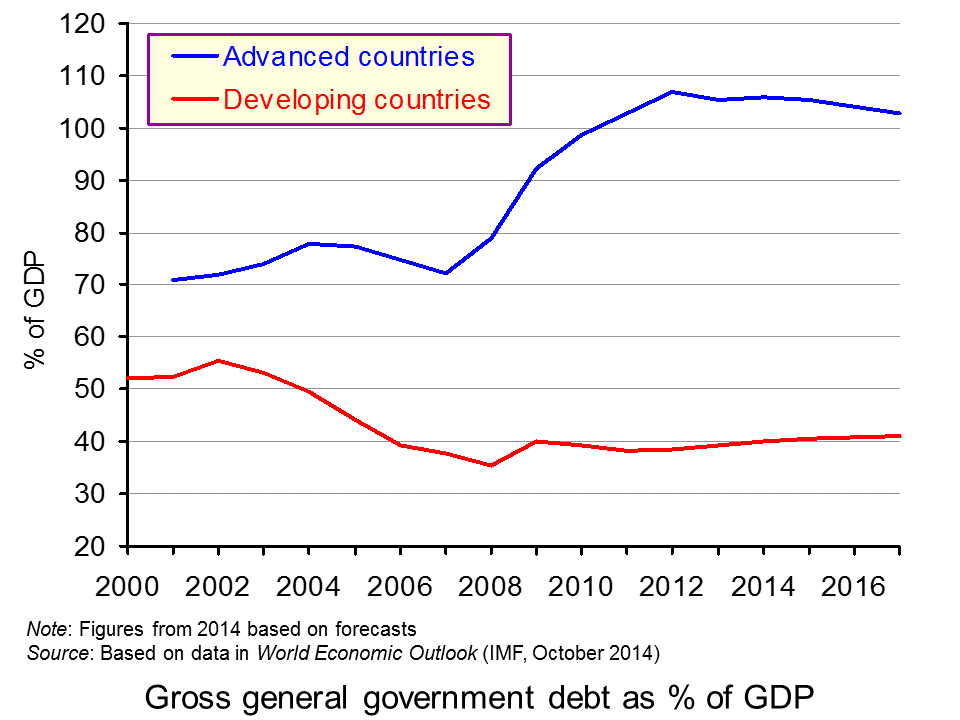 ‘The world is sinking under a sea of debt, private as well as public, and it is increasingly hard to see how this might end, except in some form of mass default.’ So claims the article below by Jeremy Warner. But just how much has debt grown, both public and private? And is it of concern?
‘The world is sinking under a sea of debt, private as well as public, and it is increasingly hard to see how this might end, except in some form of mass default.’ So claims the article below by Jeremy Warner. But just how much has debt grown, both public and private? And is it of concern?
The doomsday scenario is that we are heading for another financial crisis as over leveraged banks and governments could not cope with a collapse in confidence. Bank and bond interest rates would soar and debts would be hard to finance. The world could head back into recession as credit became harder and more expensive to obtain. Perhaps, in such a scenario, there would be mass default, by banks and governments alike. This could result in a plunge back into recession.
The more optimistic scenario is that private-sector debt is under control and in many countries is falling (see, for example, chart 1 in the blog Looking once again through Minsky eyes at UK credit numbers for the case of the UK). Even though private-sector debt could rise again as the world economy grows, it would be affordable provided that interest rates remain low and banks continue to build the requisite capital buffers under the Basel III banking regulations.
 As far as public-sector debt is concerned, as a percentage of GDP its growth has begun to decline in advanced countries as a whole and, although gently rising in developing and emerging economies as a whole, is relatively low compared with advanced countries (see chart). Of course, there are some countries that still face much larger debts, but in most cases they are manageable and governments have plans to curb them, or at least their growth.
As far as public-sector debt is concerned, as a percentage of GDP its growth has begun to decline in advanced countries as a whole and, although gently rising in developing and emerging economies as a whole, is relatively low compared with advanced countries (see chart). Of course, there are some countries that still face much larger debts, but in most cases they are manageable and governments have plans to curb them, or at least their growth.
But there have been several warnings from various economists and institutes, as we saw in the blog post, Has the problem of excess global debt been tackled? Not according to latest figures. The question is whether countries can grow their way out of the problem, with a rapidly rising denominator in the debt/GDP ratios.
Only mass default will end the world’s addiction to debt The Telegraph, Jeremy Warner (3/3/15)
Questions
- What would be the impact of several countries defaulting on debt?
- What factors determine the likelihood of sovereign defaults?
- What factors determine the likelihood of bank defaults?
- What is meant by ‘leverage’ in the context of (a) banks; (b) nations?
- What are the Basel III regulations? What impact will they have/are they having on bank leverage?
- Expand on the arguments supporting the doomsday scenario above.
- Expand on the arguments supporting the optimistic scenario above.
- What is the relationship between economic growth and debt?
- Explain how the explosion in global credit might merely be ‘the mirror image of rising output, asset prices and wealth’.
- Is domestic inflation a good answer for a country to the problems of rising debt denominated (a) in the domestic currency; (b) in foreign currencies?
 According to a report by the McKinsey Global Institute, global debt is now higher than before the financial crisis. And that crisis was largely caused by excessive lending. As The Telegraph article linked below states:
According to a report by the McKinsey Global Institute, global debt is now higher than before the financial crisis. And that crisis was largely caused by excessive lending. As The Telegraph article linked below states:
The figures are as remarkable as they are terrifying. Global debt – defined as the liabilities of governments, firms and households – has jumped by $57 trillion, or 17% of global GDP, since the fourth quarter of 2007, which was supposed to be the peak of the bad old credit-fuelled days. In 2000, total debt was worth 246% of global GDP; by 2007, this had risen to 269% of GDP and today we are at 286% of GDP.
This is not how policy since the financial crisis was supposed to have worked out. Central banks and governments have been trying to encourage greater saving and reduced credit as a percentage of  GDP, a greater capital base for banks, and reduced government deficits as a means of reducing government debt. But of 47 large economies in the McKinsey study, only five have succeeded in reducing their debt/GDP ratios since 2007 and in many the ratio has got a lot higher. China, for example, has seen its debt to GDP ratio almost double – from 158% to 282%, although its government debt remains low relative to other major economies.
GDP, a greater capital base for banks, and reduced government deficits as a means of reducing government debt. But of 47 large economies in the McKinsey study, only five have succeeded in reducing their debt/GDP ratios since 2007 and in many the ratio has got a lot higher. China, for example, has seen its debt to GDP ratio almost double – from 158% to 282%, although its government debt remains low relative to other major economies.
Part of the problem is that the lack of growth in many countries has made it hard for countries to reduce their public-sector deficits to levels that will allow the public-sector debt/GDP ratio to fall.
In terms of the UK, private-sector debt has been falling as a percentage of GDP. But this has been more than offset by a rise in the public-sector debt/GDP ratio. As Robert Peston says:
[UK indebtedness] increased by 30 percentage points, to 252% of GDP (excluding financial sector or City debts) – as government debts have jumped by 50 percentage points of GDP, while corporate and household debts have decreased by 12 and 8 percentage points of GDP respectively.
So what are the likely consequences of this growth in debt and what can be done about it? The articles and report consider these questions.
Articles
Instead of paying down its debts, the world’s gone on another credit binge The Telegraph, Allister Heath (5/2/15)
Global debts rise $57tn since crash BBC News, Robert Peston (5/2/15)
China’s Total Debt Load Equals 282% of GDP, Raising Economic Risks The Wall Street Journal, Pedro Nicolaci da Costa (4/2/15)
Report
Debt and (not much) deleveraging McKinsey Global Institute, Richard Dobbs, Susan Lund, Jonathan Woetzel, and Mina Mutafchieva (February 2015)
Questions
- Explain what is meant by ‘leverage’.
- Why does a low-leverage economy do better in a downturn than a high-leverage one?
- What is the relationship between deficits and the debt/GDP ratio?
- When might an increase in debt be good for an economy?
- Comment on the statement in The Telegraph article that ‘In theory, debt is fine if it is backed up by high-quality collateral’.
- Why does the rise is debt matter for the global economy?
- Is it possible for (a) individual countries; (b) all countries collectively to ‘live beyond their means’ by consuming more than they are producing through borrowing?
- What is the structure of China’s debt and what problems does this pose for the Chinese economy?
 The first link below is to an excellent article by Noriel Roubini, Professor of Economics at New York University’s Stern School of Business. Roubini was one of the few economists to predict the 2008 financial crisis and subsequent recession. In this article he looks at the current problem of substantial deficiency of demand: in other words, where actual output is well below potential output (a negative output gap). It is no wonder, he argues, that in these circumstances central banks around the world are using unconventional monetary policies, such as virtually zero interest rates and quantitative easing (QE).
The first link below is to an excellent article by Noriel Roubini, Professor of Economics at New York University’s Stern School of Business. Roubini was one of the few economists to predict the 2008 financial crisis and subsequent recession. In this article he looks at the current problem of substantial deficiency of demand: in other words, where actual output is well below potential output (a negative output gap). It is no wonder, he argues, that in these circumstances central banks around the world are using unconventional monetary policies, such as virtually zero interest rates and quantitative easing (QE).
He analyses the causes of deficiency of demand, citing banks having to repair their balance sheets, governments seeking to reduce their deficits, attempts by firms to cut costs, effects of previous investment in commodity production and rising inequality.
 The second link is to an article about the prediction by the eminent fund manager, Crispin Odey, that central banks are running out of options and that the problem of over-supply will lead to a global slump and a stock market crash that will be ‘remembered in a hundred years’. Odey, like Roubini, successfully predicted the 2008 financial crisis. Today he argues that the looming ‘down cycle will cause a great deal of damage, precisely because it will happen despite the efforts of central banks to thwart it.’
The second link is to an article about the prediction by the eminent fund manager, Crispin Odey, that central banks are running out of options and that the problem of over-supply will lead to a global slump and a stock market crash that will be ‘remembered in a hundred years’. Odey, like Roubini, successfully predicted the 2008 financial crisis. Today he argues that the looming ‘down cycle will cause a great deal of damage, precisely because it will happen despite the efforts of central banks to thwart it.’
I’m sorry to post this pessimistic blog and you can find other forecasters who argue that QE by the ECB will be just what is needed to stimulate economic growth in the eurozone and allow it to follow the USA and the UK into recovery. That’s the trouble with economic forecasting. Forecasts can vary enormously depending on assumptions about variables, such as future policy measures, consumer and business confidence, and political events that themselves are extremely hard to predict.
Will central banks continue to deploy QE if the global economy does falter? Will governments heed the advice of the IMF and others to ease up on deficit reduction and engage in a substantial programme of infrastructure investment? Who knows?
An Unconventional Truth Project Syndicate, Nouriel Roubini (1/2/15)
UK fund manager predicts stock market plunge during next recession The Guardian, Julia Kollewe (30/1/15)
Questions
- Explain each of the types of unconventional monetary policy identified by Roubini.
- How has a policy of deleveraging by banks affected the impact of quantitative easing on aggregate demand?
- Assume you predict that global economic growth will increase over the next two years. What reasons might you give for your prediction?
- Why have most commodity prices fallen in recent months? (In the second half of 2014, the IMF all-commodity price index fell by 28%.)
- What is likely to be the impact of falling commodity prices on global demand?
- Some neo-liberal economists had predicted that central bank policies ‘would lead to hyperinflation, the US dollar’s collapse, sky-high gold prices, and the eventual demise of fiat currencies at the hands of digital krypto-currency counterparts’. Why, according to Roubini, did the ‘root of their error lie in their confusion of cause and effect’?
 What lies ahead for economic growth in 2013 and beyond? And what policies should governments adopt to aid recovery? These are questions examined in four very different articles from The Guardian.
What lies ahead for economic growth in 2013 and beyond? And what policies should governments adopt to aid recovery? These are questions examined in four very different articles from The Guardian.
The first is by Nouriel Roubini, Professor of Economics at New York University’s Stern School of Business. He was one of the few economists to predict the collapse of the housing market in the USA in 2007 and the credit crunch and global recession that followed. He argues that continuing attempts by banks, governments and individuals to reduce debt and leverage will mean that the advanced economies will struggle to achieve an average rate of economic growth of 1%. He also identifies a number of other risks to the global economy.
 In contrast to Roubini, who predicts that ‘stagnation and outright recession – exacerbated by front-loaded fiscal austerity, a strong euro and an ongoing credit crunch – remain Europe’s norm’, Christine Lagarde, head of the IMF and former French Finance Minister, predicts that the eurozone will return to growth. ‘It’s clearly the case’, she says, ‘that investors are returning to the eurozone, and resuming confidence in that market.’ Her views are echoed by world leaders meeting at the World Economic Forum in Davos, Switzerland, who are generally optimistic about prospects for economic recovery in the eurozone.
In contrast to Roubini, who predicts that ‘stagnation and outright recession – exacerbated by front-loaded fiscal austerity, a strong euro and an ongoing credit crunch – remain Europe’s norm’, Christine Lagarde, head of the IMF and former French Finance Minister, predicts that the eurozone will return to growth. ‘It’s clearly the case’, she says, ‘that investors are returning to the eurozone, and resuming confidence in that market.’ Her views are echoed by world leaders meeting at the World Economic Forum in Davos, Switzerland, who are generally optimistic about prospects for economic recovery in the eurozone.
The third article, by Aditya Chakrabortty, economics leader writer for The Guardian, looks at the policies advocated at the end of World War II by the Polish economist, Michael Kalecki and argues that such policies are relevant today. Rather than responding to high deficits and debt by adopting tough fiscal austerity measures, governments should adopt expansionary fiscal policy, targeted at expanding infrastructure and increasing capacity in the economy. That would have an expansionary effect on both aggregate demand and aggregate supply. Sticking with austerity will result in continuing recession and the ‘the transfer of wealth and power into ever fewer hands.’
 But while in the UK and the eurozone austerity policies are taking hold, the new government in Japan is adopting a sharply expansionary mix of fiscal and monetary policies – much as Kalecki would have advocated. The Bank of Japan will engage in large-scale quantitative easing, which will become an open-ended commitment in 2014, and is raising its inflation target from 1% to 2%. Meanwhile the Japanese government has decided to raise government spending on infrastructure and other government projects.
But while in the UK and the eurozone austerity policies are taking hold, the new government in Japan is adopting a sharply expansionary mix of fiscal and monetary policies – much as Kalecki would have advocated. The Bank of Japan will engage in large-scale quantitative easing, which will become an open-ended commitment in 2014, and is raising its inflation target from 1% to 2%. Meanwhile the Japanese government has decided to raise government spending on infrastructure and other government projects.
So – a range of analyses and policies for you to think about!
Risks lie ahead for the global economy The Guardian, Nouriel Roubini (21/1/13)
Eurozone showing signs of recovery, says IMF chief The Guardian, Graeme Wearden (14/1/13)
Austerity? Call it class war – and heed this 1944 warning from a Polish economist The Guardian, Aditya Chakrabortty (14/1/13)
Bank of Japan bows to pressure with ‘epoch-making’ financial stimulus The Guardian, Phillip Inman (22/1/13)
Questions
- What are the dangers facing the global economy in 2013?
- Make out a case for sticking with fiscal austerity measures.
- Make out a case for adopting expansionary fiscal policies alongside even more expansionary monetary policies.
- Is is possible for banks to increase their capital-asset and liquidity ratios, while at the same time increasing lending to business and individuals? Explain.
- What are the implications of attempts to reduce public-sector deficits and debt on the distribution of income? Would it be possible to devise austerity policies that did not have the effect you have identified?
- What will be the effect of the Japanese policies on the exchange rate of the yen with other currencies? Will this be beneficial for the Japanese economy?
On 28 November 2010, a deal was reached between the Irish government, the ECB, the IMF and other individual governments to bail out Ireland. The deal involved an €85bn package to bail out the collapsing Irish banks. Not all of the money went directly to the banks and the Irish government did set aside some of the loan. However, some of this money will now be required by four key lenders in Ireland, after a stress test by a group of independent experts found that the Republic of Ireland’s banks need another €24bn (that’s £21.2bn) to survive the continuing financial crisis. Allied Irish Banks require €13.5bn, Bank of Ireland €5.2bn, Irish Life €4bn and EBS a meager €1.5bn. The governor of the central bank, Professor Patrick Honohan said:
‘The new requirements are needed to restore market confidence, and ensure banks have enough capital to meet even the markets’ darkest estimates.’
The stress test focused on an assumption of a ‘cumulative collapse’ in property prices by 62%, together with rising unemployment. Following this, the Irish Finance Minister announced the government’s intention to take a majority stake in all of the major lenders. The Irish banks have been told they need to reduce the net loans on their balance sheets by some €71bn (£63bn) by the end of 2013. This process of deleveraging is likely to generate further losses, as many loans and assets will be sold for less than their true value. The causes of this ongoing financial crisis can still be traced back to the weakness within the Irish economy and more specifically to mortgage accounts being in arrears following the property market bubble that burst. A key question will be whether this second bail-out is sufficient to restore much needed confidence in the economy and particularly in the banking sector. The articles below consider this ongoing crisis.
Irish hope it is second time lucky for bail-out Telegraph, Harry Wilson (1/4/11)
Irish Bank needs extra €24bn euros to survive BBC News (31/3/11)
Ireland forced into new £21bn bailout by debt crisis Guardian, Larry Elliott and Jill Treanor (31/3/11)
The hole in Ireland’s banks is £21bn BBC News Blogs: Peston’s Picks, Robert Peston (31/3/11)
ECB has given Ireland serious commitment Reuters (1/4/11)
Ireland banking crisis: is the worst really over? Guardian: Ireland Business Blog, Lisa O’Carroll (1/4/11)
Ireland: a dead cert for default Guardian, Larry Elliott (1/4/11)
Timeline: Ireland’s string of bank bailouts Reuters (31/3/11)
Questions
- What is the process of deleveraging? Why is likely to lead to more losses for Ireland’s banks?
- What are the causes of the financial crisis in Ireland? How do they differ from financial crises around the world?
- What are the arguments for and against bailing out the Irish banks?
- Will this second bailout halt the possible contagion to other Eurozone and EU members?
- If this second bailout proves insufficient, should there be further intervention in the Irish economy?
 ‘The world is sinking under a sea of debt, private as well as public, and it is increasingly hard to see how this might end, except in some form of mass default.’ So claims the article below by Jeremy Warner. But just how much has debt grown, both public and private? And is it of concern?
‘The world is sinking under a sea of debt, private as well as public, and it is increasingly hard to see how this might end, except in some form of mass default.’ So claims the article below by Jeremy Warner. But just how much has debt grown, both public and private? And is it of concern? As far as public-sector debt is concerned, as a percentage of GDP its growth has begun to decline in advanced countries as a whole and, although gently rising in developing and emerging economies as a whole, is relatively low compared with advanced countries (see chart). Of course, there are some countries that still face much larger debts, but in most cases they are manageable and governments have plans to curb them, or at least their growth.
As far as public-sector debt is concerned, as a percentage of GDP its growth has begun to decline in advanced countries as a whole and, although gently rising in developing and emerging economies as a whole, is relatively low compared with advanced countries (see chart). Of course, there are some countries that still face much larger debts, but in most cases they are manageable and governments have plans to curb them, or at least their growth.



